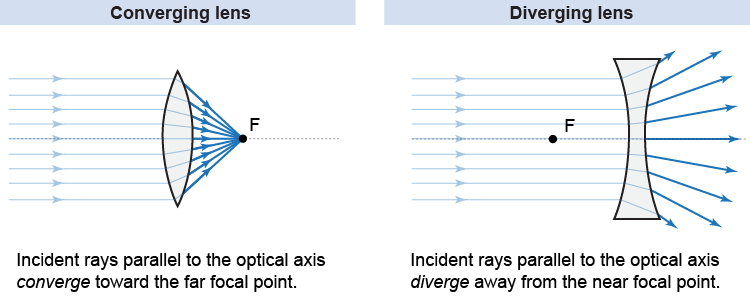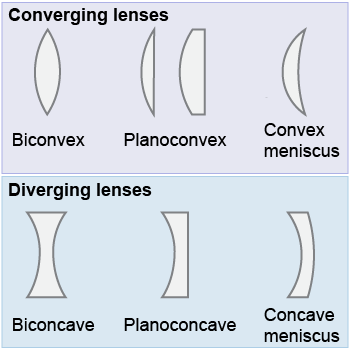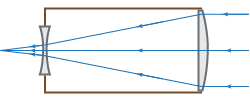|
There are two basic kinds of lenses: converging and diverging. They differ in how they bend parallel light rays that are incident upon them. A convex lens is a converging lens, which means that it bends parallel light rays toward the optical axis. When a light ray strikes the curved surface of a converging lens, it is bent toward the normal through Snell’s law—just as it bends for a sloped side of a glass prism. These bends cause incident parallel light rays to converge to an image location beyond the lens. A converging lens is typically convex, that is, thicker in its middle and thinner around its edges. A magnifying glass is a commonly used converging lens. 
|

|
A concave lens is a diverging lens, which means that the lens bends parallel light rays away from the optical axis. When incident light strikes the surface of a diverging lens, light is still refracted toward the normal—but in this case the normal to the surface points away from the optical axis! A diverging lens bends light in a way that appears to focus it at a point on the front side of the lens. A diverging lens is thinner in its middle and thicker around its edges—its surface is concave. A diverging lens can be used as a peep hole in a door to allow you to see a wide field of view outside the door. 
|
 The illustration above shows only one example of each kind of lens. A biconvex lens has an outwardly curved surface on both sides. There are also other kinds of convex lenses, such as when one side is flat (a planoconvex lens). Similarly, there are diverging lenses other than the biconcave lens shown above. In physics class you may focus only on symmetrical biconvex and biconcave lenses, but when optics are designed for technology or scientific instruments, a wider variety of lenses are typically used to correct for aberrations and distortions.
The illustration above shows only one example of each kind of lens. A biconvex lens has an outwardly curved surface on both sides. There are also other kinds of convex lenses, such as when one side is flat (a planoconvex lens). Similarly, there are diverging lenses other than the biconcave lens shown above. In physics class you may focus only on symmetrical biconvex and biconcave lenses, but when optics are designed for technology or scientific instruments, a wider variety of lenses are typically used to correct for aberrations and distortions. 
|
Would a converging or diverging lens be used in a magnifying glass?
 |
A converging lens would be used in a magnifying glass. The subject is held close to the glass, at or closer than the focal point, so the rays of light become spread out and the image is enlarged. 
|
 The telescope created by Hans Lippershey and refined by Galileo Galilei had two different lenses, as shown in the figure at right. What kinds of lenses were each, converging or diverging?
The telescope created by Hans Lippershey and refined by Galileo Galilei had two different lenses, as shown in the figure at right. What kinds of lenses were each, converging or diverging?
 |
The lens at the entrance to the telescope—the one on the right-hand side of the figure—is a converging lens (a planoconvex lens). The lens at the eyepiece—at the left-hand side of the figure—is a diverging lens (a biconcave lens). 
|

